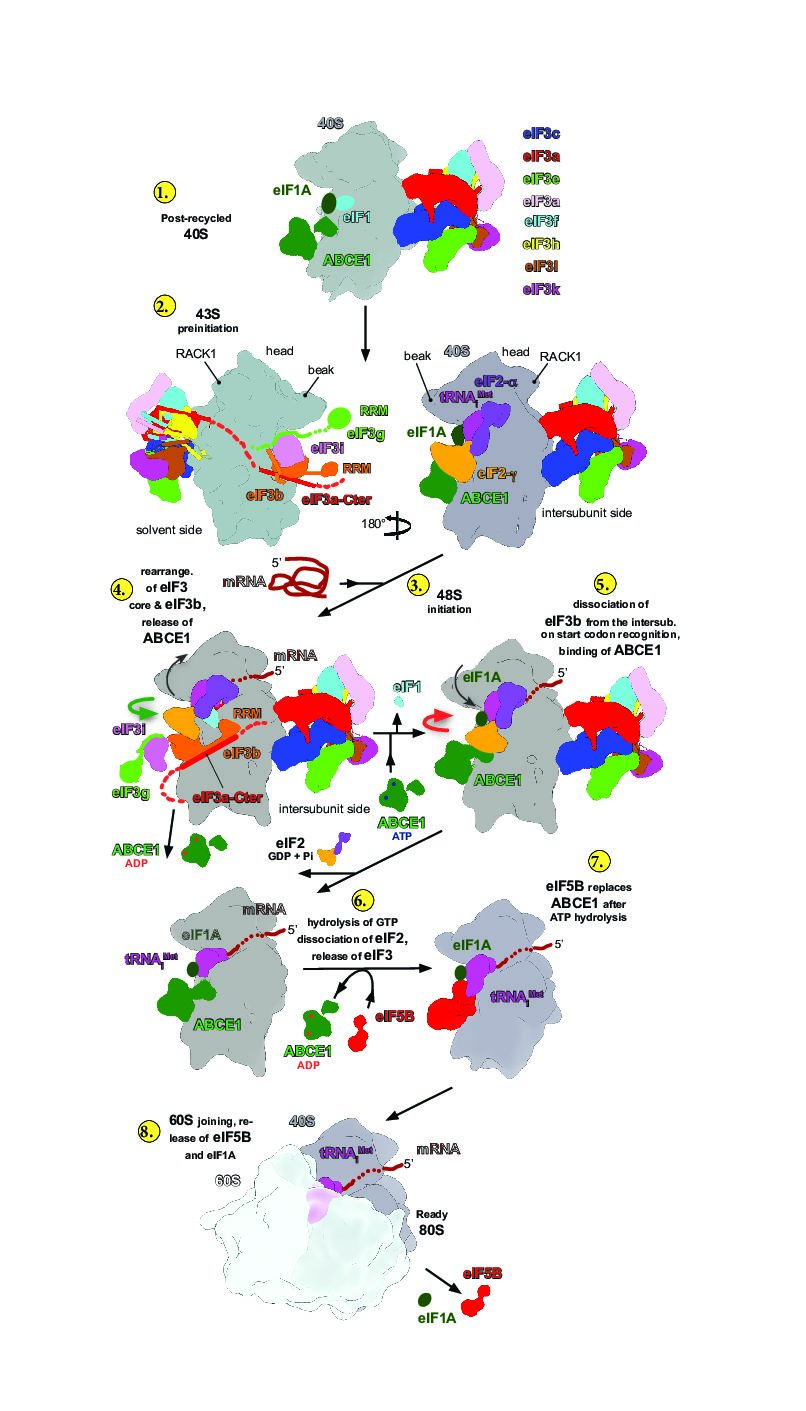Protein synthesis is the essential process required for growth and development in all living organisms. It relies on the translation of the messenger RNA (mRNA) into amino acids that fold and become functional proteins. Translation can be divided into four stages: initiation, elongation, termination and recycling. Each stage is composed of multiple steps that require extensive rearrangements of subunits of its key player around the ribosome, a hybrid RNA-protein complex with a size ranging from ~ 2.5 MDa (in bacteria) to ~ 4 MDa (in mammals) [1].
The ribosome is composed of two subunits: small (SSU or 40S) and large (LSU or 60S). The space between the subunits comprises three binding sites called: A (aminoacyl), P (peptide) and E (exit) sites, where different translation factors and the transfer RNAs (tRNAs) carrying the amino acids interact during the different stages of translation. The rate-limiting and principally regulated step of the translation process is the initiation step, where the SSU interacts with mRNA, leading eventually through a complex sequence of interactions to the accommodation of the mRNA start-codon at the ribosomal P-site and the joining of both subunits. The subunit SSU is responsible for RNA-decoding and mRNA binding [2,3], whereas LSU possesses mainly the amino acid polymerization function, as it contains the peptidyl transferase center [4]. Therefore, SSU is a central actor during the translation initiation process.
Translation initiation process in eukaryotes requires the interaction of a dozen protein eukaryotic initiation factors (eIF) at different stages of the process. The canonical translation initiation mechanism is based on the recruitment of a 5′ 7-methyl guanosine (m7G) cap leading the coding mRNA to the ribosome that is the most common process through which mRNA is translated in eukaryotes. The cap is linked to the first 5’ nucleotide of the mRNA, and in higher eukaryotes two riboses of the following nucleotides are 2’-O methylated. This canonical pathway is composed of four main steps: i) preinitiation, ii) mRNA recruitment, iii) scanning and start-codon recognition and iv) ribosomal subunit joining.
Many intermediate stages of this process remain to be understood and recent breakthroughs in cryo-electron microscopy (cryo-EM) enable now the visualization of these steps at near-atomic resolutions and fill the missing gap in the understanding of the protein synthesis regulation mechanisms. When compared to bacterial translation initiation, this process in eukaryotes remains largely underexplored. We aim to get insights into the mechanism and structural rearrangements of the initiation complexes during mRNA attachment to the 43S, scanning process and upon start-codon recognition during canonical cap-dependent mammalian translation initiation A deeper structural and functional understanding of translation initiation in mammals is crucial for the identification of the kinetoplastid-specific features of this complex machinery in the other axis of our research.

Simplified model of eukaryotic translation initiation. The model is based on different structures of eukaryotic (pre)-initiation complexes. Different stages of the process are highlighted by numbers in yellow circles. Thick curved green arrow indicates the eIF3b-i-g module relocation from the solvent to the intersubunit side of the 40S subunit, and red curved arrow indicates its relocation away from the intersubunit face, probably back to the solvent side, till the release of eIF3. Dark gray arrows indicate the conformational change of the eIF2-TC upon eIF3b-i-g relocation and departure to and from the intersubunit face of the 40S, which may reflect its previously described PIN and POUT conformations. From Hashem and Frank, COSB 2018